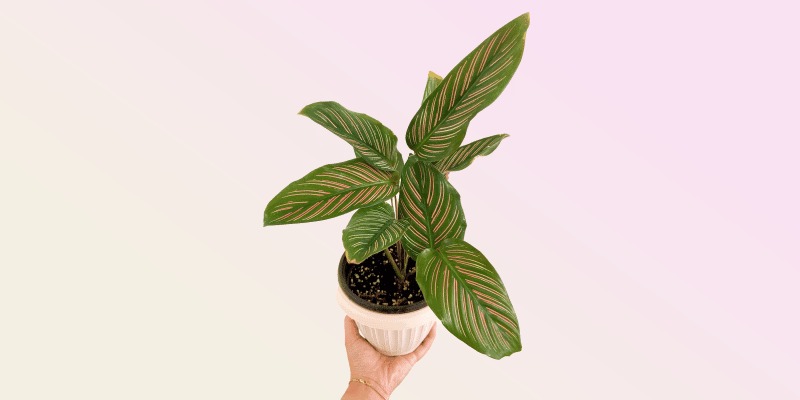Calathea care can be a challenge, but when you get the conditions just right… there’s little as rewarding.
We’re going to cover how to avoid the most common mistakes people make with their Calathea, tricks for giving them the high humidity they like, and highlight our favorite Calathea varieties (warning… there’re quite a few).
Since Calathea can’t be propagated by stem, we’ll talk about how to easily grow new plants, too.
Table of Contents
Calathea Care Guide
History, habitat, and characteristics
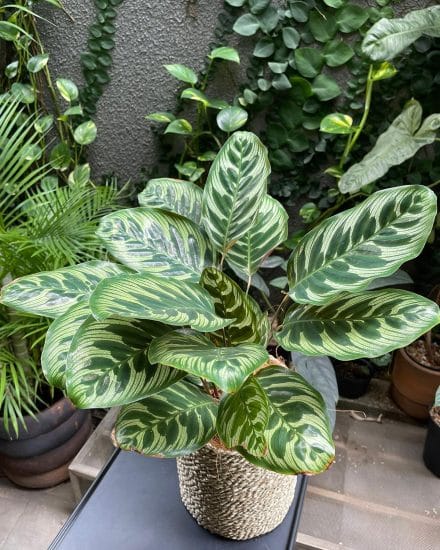
As you’ve probably guessed by the wide variety of looks available, Calathea isn’t just one species or plant, it’s an entire genus! In their native tropical regions of Central and South America they’ve been widely appreciated for their eye-catching leaves and patterns.
Traditionally they’ve been used to wrap food, weave baskets, and they’ve similarly woven their way into many regional cultures.
This is what I find so beautiful about Calathea: the unique shapes, color patterns, and brilliant contrasts. It was honestly love at first sight. And second. And third.
As Calathea is a genus, you’ll see many species underneath it, but less than there used to be. The genus name Calathea was derived from the Greek words kalathos, meaning “basket” and anthos, meaning “flower,” referencing their characteristic use in weaving baskets and wrapping foods with their distinctively patterned, lanceolate leaves.
Due to its non-toxic nature, Calathea is safe for furry friends. I can see why it’s such a popular material!
Calathea is sometimes referred to as the ‘prayer plant’ (confusing, because it’s not the only one) due to its amazing nyctinastic behavior. This occurs when its leaves open up towards the sun during the day, and then fold in at night, creating a ‘praying’ pose — as though the plant is waiting for the morning light. This adaptation is what helps Calathea maximize sunlight exposure, and conserve water at night.
We usually cover plants on Plantcarefully that are suitable for beginners and seasoned green thumbs alike: Calathea is a little bit different. I’d categorize this as more of an intermediate plant — if you haven’t taken care of an indoor plant before, this isn’t the one I’d start with.
That being said, once you calibrate to its requirements, they’re relatively easy to keep happy. So if you are a beginner and looking for an adventure: let’s go right into this Calathea care guide! But first… the varieties.
Calathea varieties
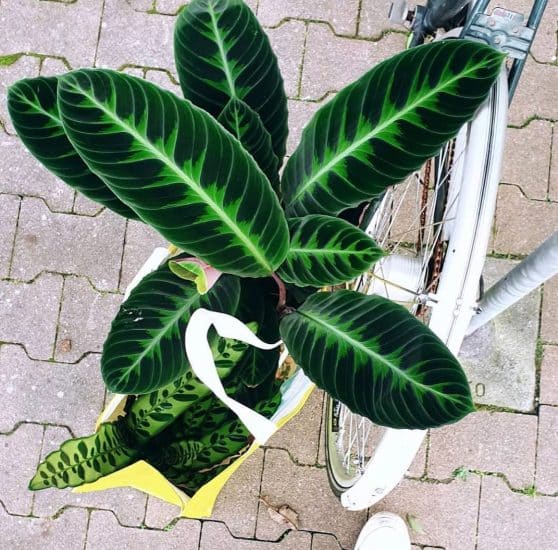
There are dozens and dozens of Calathea varieties (and species) to choose from, but less than there used to be, as many have been reclassified as Goeppertia. Most are still known under their previous classification, so we’ll refer to them as Calathea for this article.
Either way, the care is the same, so let’s dive in.
Calathea orbifolia
(Our full Calathea orbifolia guide is available here.)
Calathea orbifolia, a true showstopper, is an alluring houseplant that boasts remarkable circular leaves, showcasing a blend of light and dark green tones. The foliage is decorated with hypnotizing zebra-like fine lines, forming intricate patterns that are sure to dazzle plant lovers.
Calathea makoyana
(Our full Peacock Plant guide is available here.)
I still have my first Calathea and remember the day I took it home. It was a Calathea makoyana, the Peacock plant. Beautiful, delicate leaves with bright purple undersides. It almost looked as if it had another plant entirely inscribed upon it.
It’s now known as Geoppertia makoyana, but its striking appearance remains.
Calathea Ornata
Also known as the Pinstripe Plant, it features dark green leaves with light pink stripes fanning out to its edges. Its glossy leaves help repel insects (for the most part).
(Our full Pinstripe Plant guide is available here).
Calathea veitchiana Medallion
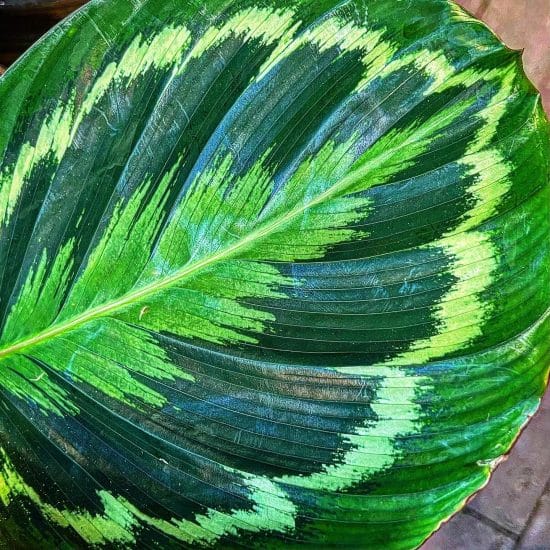
Calathea Medallion is a captivating houseplant known for its round, deep green leaves adorned with mesmerizing patterns, originating from the lush forests of Brazil. This showstopper is not only eye-catching but also exhibits heliotropic behavior, following the sun throughout the day. This Calathea plant does great in low light and features almost a pale neon contrast on its deep green leaves.
(Full Calathea Medallion care guide here.)
Calathea Dottie
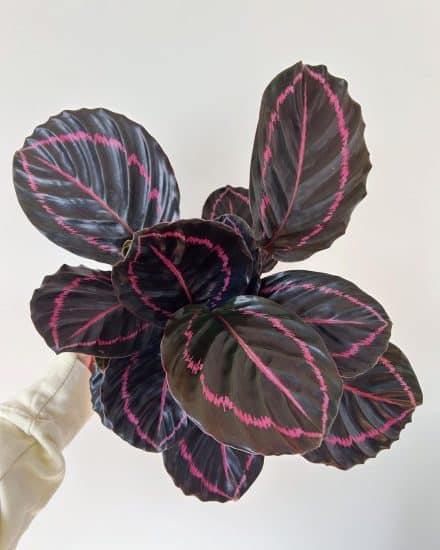
Pictures rarely do this Calathea plant justice. Its leaves are beautifully variegated, moving from an almost black to stunning inscribed pink leaves, with ribbing and striping throughout. Requires medium-to-low light to maintain its delicate color.
(Full Calathea Dottie care guide here.)
Calathea ‘Triostar’
A Calathea hybrid that’s sporty, with pink to white to green spears emerging from its central stems. The leaves are unlike any other and usually grow to around a foot each.
Calathea Lietzei ‘White Fusion’
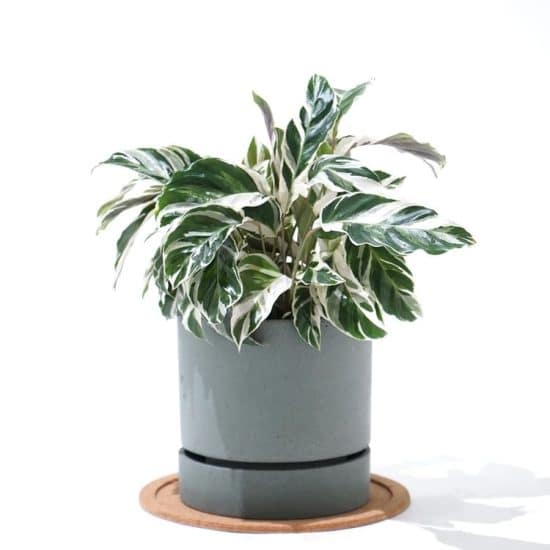
Calathea lietzei ‘White Fusion’ has striking white variegation and grows almost in a helix form from its center. Having less chlorophyll than other varieties, it may need slightly more light than you’re used to with Calathea care, but the rewards are plentiful. Make sure to spray and wipe down its leaves from time to time, since this is a plant that shouldn’t be left in the dust.
Calathea Majestica White Star
The White Star Calathea is another hybrid with long, striking leaves. Sensing a pattern? This plant has fine alternating white and green stripes and often appears pinkish with some cultivars. There is a wide variety in appearance here, so I recommend buying in person.
Calathea musaica
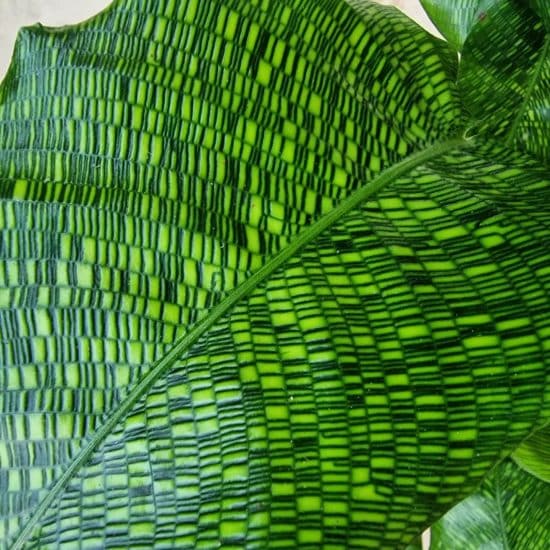
Also known as the “network plant” for its unique mosaic pattern of light green and yellow that looks like connected cell walls or stained glass. Easier to grow than other Calatheas, but it still does prefer a moist soil and plenty of humidity. (Our full Calathea musaica guide is available here.)
Light
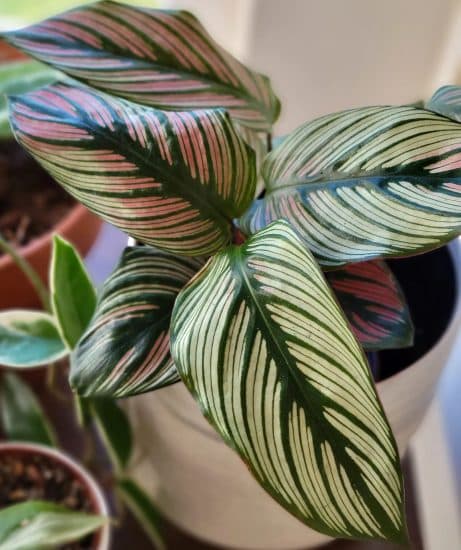
Calathea care almost starts and ends with light: this is a plant that actually prefers medium-to-low light, even 10-12 feet away from a window. This can make placement difficult, but it also means your Calathea can occupy a unique location in your home.
When we talk about window placement, usually we’ll use cardinal directions. North and east windows tend to get the least amount of harsh direct sun, but with how far away Calathea plants like to be, the window direction is actually less important than the distance.
With variegation, you’ll notice it fading to green if your plant isn’t getting enough light. Prayer plants really thrive in their own, unique low-ish (I know, very scientific) light.
So how do you know you’ve hit the right amount? A mixture of vibrant growth and preserved variegation.
Signs of too little light include dying leaves, slow growth, dull colors, and a complete loss of variegation as the leaves turn green and attempt to extract more light.
Too much light? You’ll notice your plant’s leaves looking dried out and crispy, with brown edges.
Grow lights? I’ve never known someone to need one with a prayer plant, but generally, I’d undersize it, go for LED, and make sure it’s full spectrum. Turn it off at night so you can see this plant dance.
Tips:
- Avoid direct sunlight. In fact, I’d also recommend avoiding even bright, indirect light. Low to medium is best.
- Rotate your plant regularly to ensure the sun hits it evenly.
- If you need to increase the amount of light the plant is receiving, do so gradually to avoid stressing the plant.
- Monitor the leaves of the Calathea and look for thin and long growth, bleached or yellowed leaves, to determine whether it’s getting too much or too little light.
Remember, variegated Calathea needs a bit more light than non-variegated, and will grow about half as quickly as a typical plant, so brace for slow growth.
Water
Usually, water frequency is the first subject we’ll cover in a care guide, but here I’d like to highlight the source of your water. Calathea care depends a little bit on this: they can be kind of picky when it comes to tap water.
I’d recommend using filtered or distilled water if possible, and rainwater is the best if you feel up for collecting it!
Okay, spiel out of the way.
Like other indoor plants, the Rattlesnake plant prefers infrequent but large amounts of water. We’ll cover soil in a moment, but make sure excess water can leave your container.
If you’re wondering if it’s time to water: check the soil — it’ll happily tell you. Stick a finger in, and if it’s dry up to the second knuckle, give it some fresh water.
- During the growing season, water your Calathea plant more frequently.
- Filtered or distilled water is great; rainwater is best.
- Let the top two inches of soil dry out almost completely between each watering.
- Look for signs of overwatering or underwatering, such as limp and droopy leaves, to help you adjust your watering schedule.
Temperature and humidity
Reaching the ideal temperature and humidity levels for tropical plants like Calathea while remaining comfortable yourself can be tricky.
Let’s cover temperature first. Typically prayer plants do well between 65-80 F. Try to keep them away from drafts or air conditioners because they won’t be getting a lot of heat from the sunlight.
Humidity is a bit trickier. Prayer plants prefer humidity levels above 50%, which can start to get a bit uncomfortable for the humans in your house. If you notice slow growth and few new leaves, low humidity levels are likely at least part of the problem. But fear not:
Tips for creating a humid environment
- Group your Calathea plant collection together,. Not only does this filter the light, but also raises the local humidity.
- Use a pebble tray filled with water underneath the plant. As the water evaporates from the larger surface area of the stones, it’ll increase your humidity.
- If all else fails: buy a small humidifier and place it nearby.
- Avoid misting: this typically attracts pests and fungus.
Soil and planting
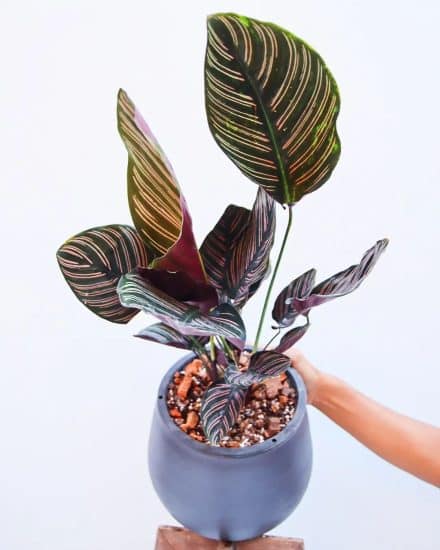
You can find Calathea-specific soils, but we can give you the same recipe right here.
Your Calathea soil should be:
- 50% potting soil
- 25% perlite
- 25% cactus soil
For containers, start small. The key is drainage holes. You’ll want to keep an eye on them for when the roots start poking out. This is a good sign to go a size up. Try to keep the depth the same as it was before so you’re not burying too much stem or any leaves in a deeper pot.
Fertilization is optional, and only during the spring/summer. If you do decide to fertilize, go with a balanced liquid fertilizer at half strength. Fall and winter? It’s time for a break.
If you have them, toss in some worm castings or organic matter every few months.
Propagation guide
Since Calathea can’t be propagated with stem cuttings, instead we’re going to use division to propagate our plants.
If you’re not experienced with division propagation, don’t worry, it’s simple! It just requires a bit of patience and care.
Propagating Calathea with root division
Before we start, we’ll want to select a mature, healthy Calathea with plenty of leaves. If you just brought one home, you’ll want to give it some time to acclimate.
Okay, have a plant at the ready? Let’s get started with propagation: root division can be tricky the first few times but anyone can learn to do this and there’s minimal risk to the parent plant.
- Dig out your plant and remove it from the soil.
- If it’s tightly root bound, you’ll need to gently pry the roots apart, loosening them up with water if it’s too dense. If you really need to, you can even cut roots to separate them.
- Place each newly divided plant in its own pot, add a fresh potting soil mix (our recommendation is in the soil section above), and water thoroughly. Avoid overwatering to prevent the potentially stressed roots from getting waterlogged and damaged.
Propagation is one of my favorite parts of owning indoor plants, and if you like to grow Calathea… why not make more?
It’s a great way to expand your collection, clone a plant you love, and make great gifts for friends, and family. Heck, even strangers on the street have wound up with a plant from me!
I recommend starting this during the growing season (spring through summer).
Common issues
As we mentioned in the intro, Calathea aren’t the easiest indoor plants to keep. The most common issues we see are caused by one of the following:
- Not having a humid environment. Your humidity level is what usually controls how fast you can grow Calathea.
- Using tap water that’s too hard or that passes through a water softener.
- Using a pot without a drainage hole, which lets excess water accumulate.
- Not recognizing that Calathea needs lower light levels than many other indoor plants.
Okay, let’s get into a bit more depth with a few of the most common issues.
Yellow leaves
Okay, we started with a tough one. Yellow leaves are tricky because there are a few different causes. First, you need to determine: are they dry and yellowing, or limp and falling off? If they feel dry and crispy, it could be exposure to direct sunlight. Next, is the soil wet or allowed to stay damp? If so, this probably indicates over-watering/not enough drainage which leads to rot. We’ll cover how to deal with that in our next section.
Fading leaves
The nightmare of any variegated plant owner — fear not, they’re not reverting! Most likely, you don’t have enough light. While Calathea doesn’t love light, it still needs a medium amount (this plant does like to show off — it’s not called the Peacock plant for nothing). If you’re noticing all green leaves, it’s likely compensating. Just move it a bit closer to a window or add an LED nearby.
Remember, if you want your Zebra plant to keep its stripes: bright indirect light works for most plants, but not this one. So don’t overcompensate all at once, but make adjustments little by little.
Diseases and pests
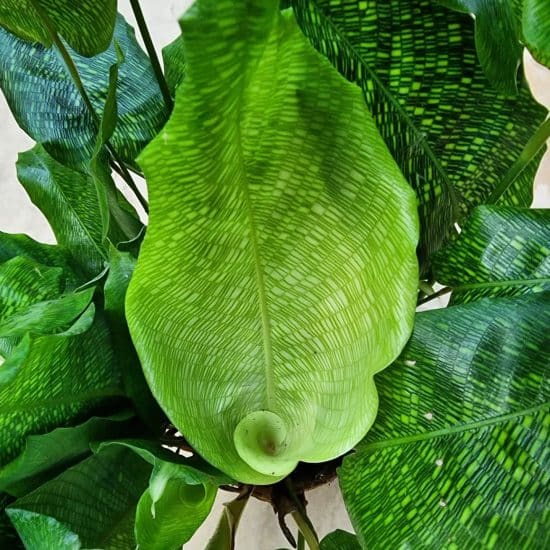
Calathea mostly suffer from the same disease and pest issues that most houseplants do. That doesn’t make them any less bothersome, but almost all these issues are caused by a weakened plant that’s become food for something a bit opportunistic. So check the above sections on care to close the door on those opportunities after dealing with the acute issue.
Pests. Insects like spider mites, mealybugs, or especially fungus gnats can make an appearance pretty quickly. All are dealt with similarly: remove the insects from the surface with cold water (spray your plant down), repot into new soil, and apply neem oil. You’ll often notice the plant turning yellow or brown first. This is a good sign to look closer and make sure it isn’t hosting any unwelcome guests.
If you spray your leaves with water, don’t! Or wipe them down right after you do it, because there are better ways to get enough humidity for your plants without attracting bugs to your Calathea’s leaves.
Root rot
This can quickly discolor your plant’s dark green leaves and affects all indoor plants (and Calathea varieties). The answer is to cut away any affected roots (they’ll be black, mushy, and probably a bit smelly) and repot in a quick-draining medium. The Calathea’s root system is delicate, but you will need to do some cutting here.
Consider watering less frequently or adding LECA, sand, or perlite to your pot.
Conclusion
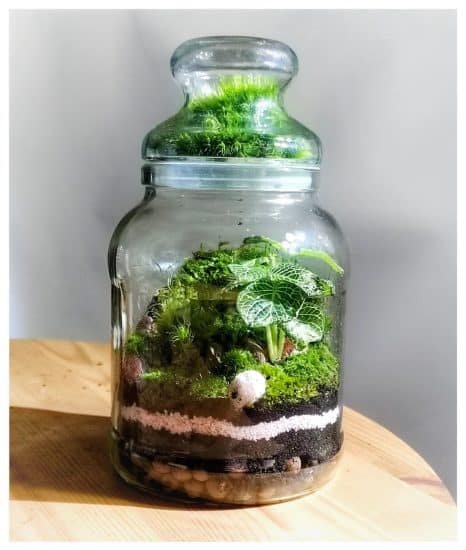
Calathea plants aren’t designed for the beginner, but do thrive indoors if you don’t give them too much direct sunlight and keep them comfy in an average room temperature.
They can be picky drinkers, so filtered water works best, and if you notice variegation dropping, consider increasing the light.
Calathea plants are absolutely exquisite: who wouldn’t love a plant that looks like a Zebra?
FAQ
What are prayer plants? Is the Calathea one?
Calathea is sometimes referred to as a Prayer plant for its tendency to lower its leaves in the evening as it receives less light. This particular habit is a form of nyctinasty, a phenomenon in which the plant undergoes multiple daily leaf movements which follow the sun’s own path. This way, it receives optimal light absorption and water intake.
Are Calathea plants considered tropical plants?
They are! Most indoor plants originate from tropical environments where they naturally tolerate lower light conditions, just like your average apartment!
How do you grow Calathea from seed?
Pollination is very difficult for Calathea and very few people succeed in growing these plants from seed. I highly recommend propagation instead, which you can read about above.
What’s the most important area in Calathea care?
I think the thing that trips most people up is just how little light these want, along with adapting to less watering frequency during the winter months.

